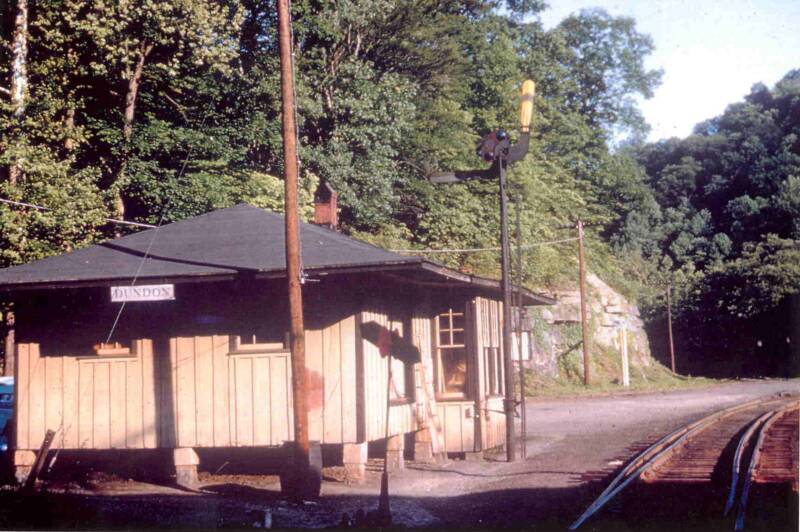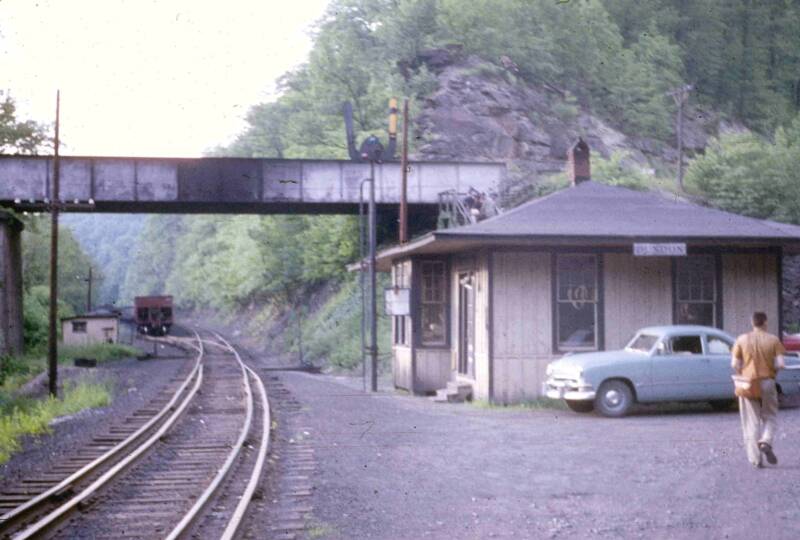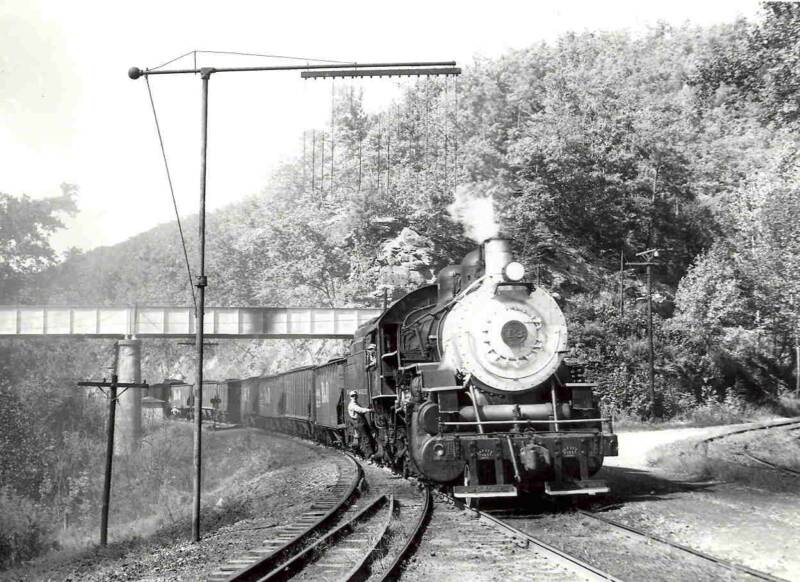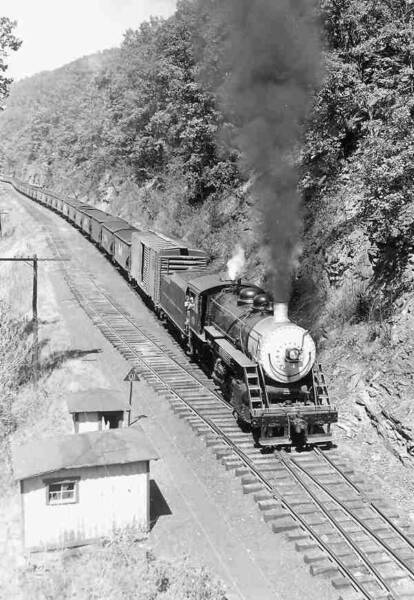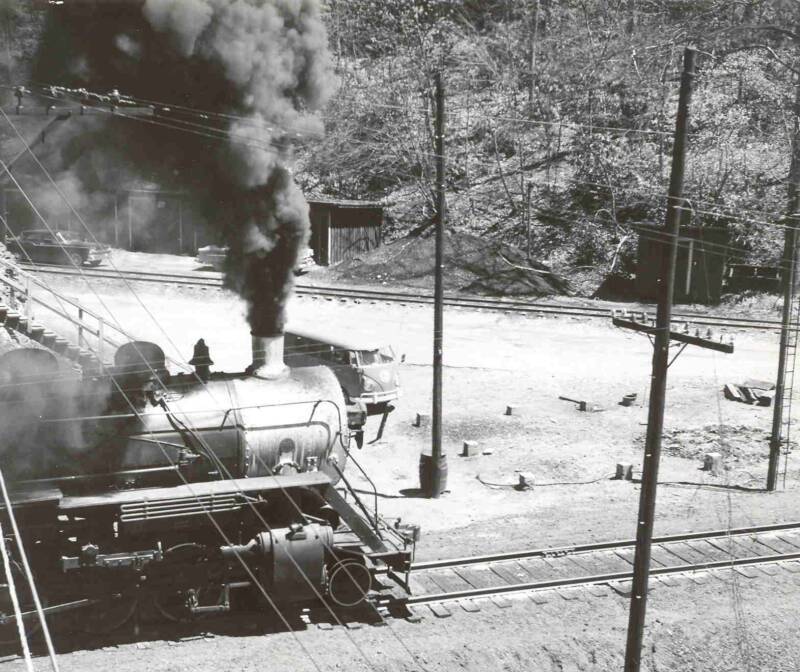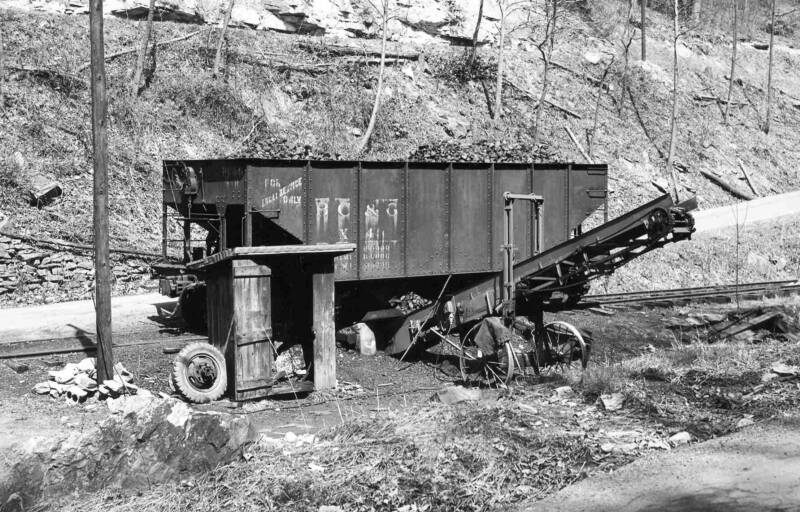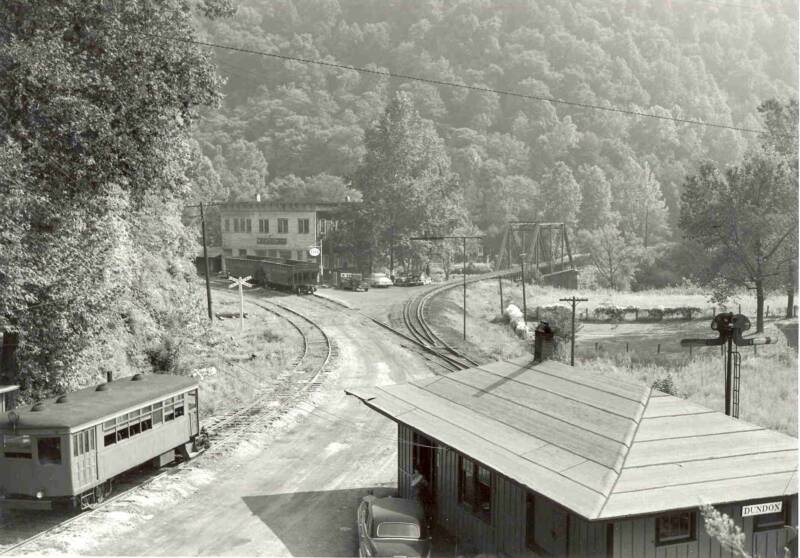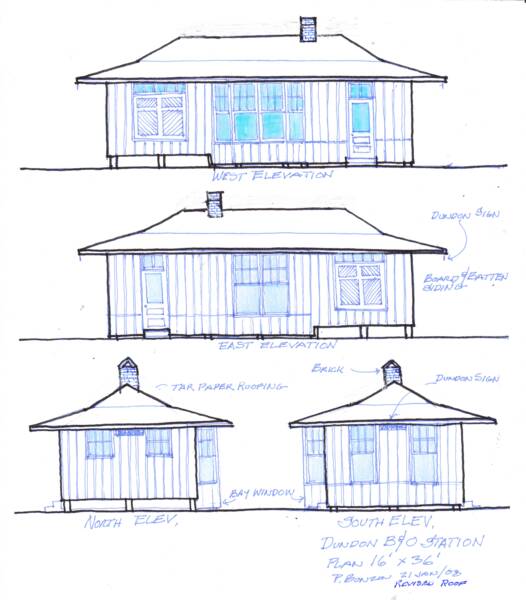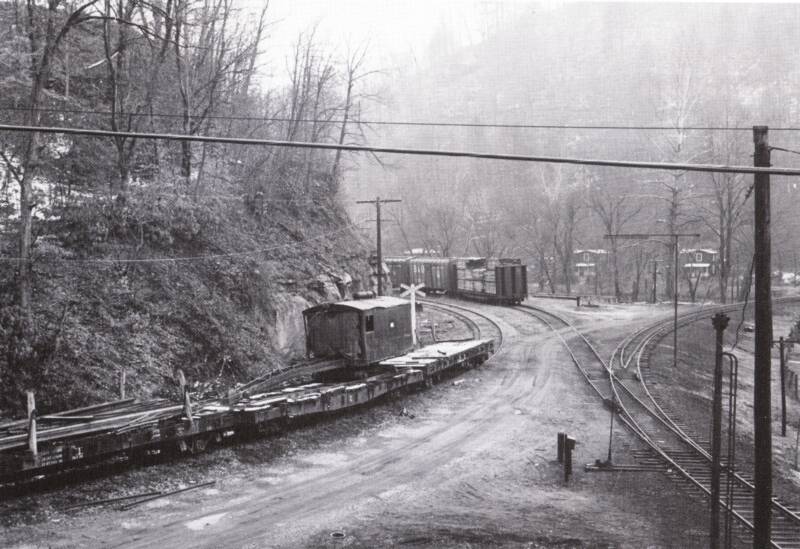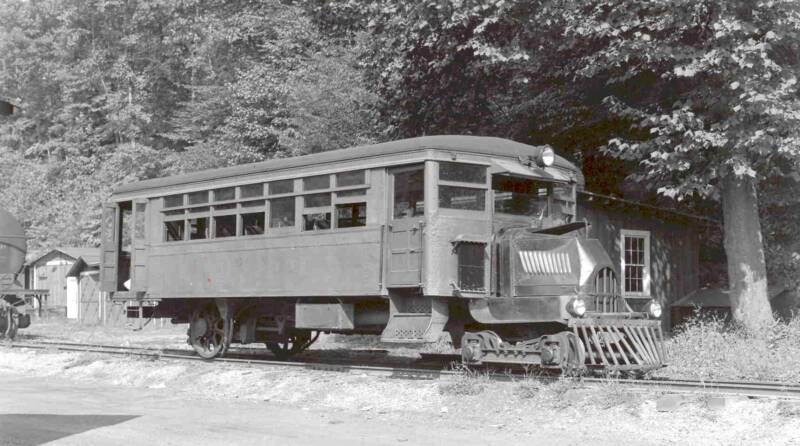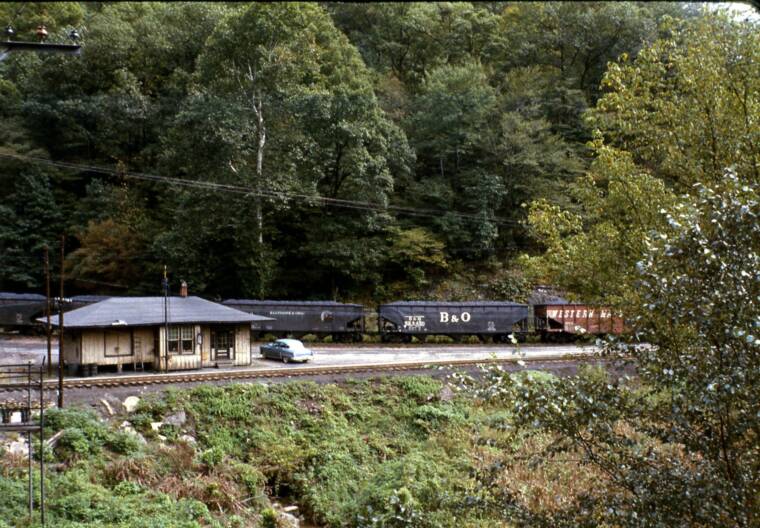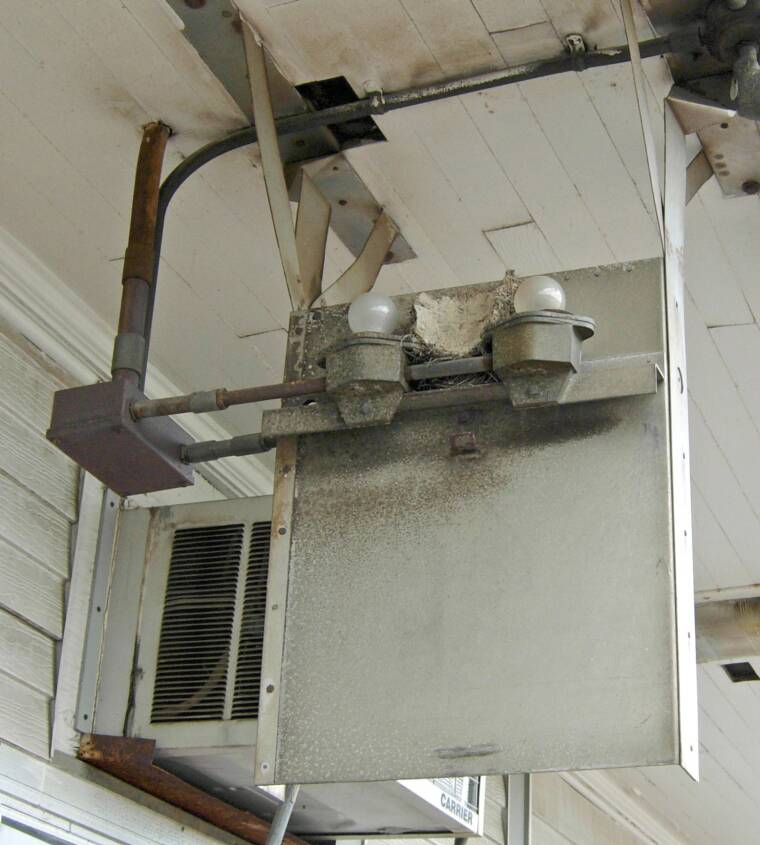B&O Station
At the point where the BG&G main intersected the B&O there sat a small, simple frame station. Behind it there were several small sheds. Because there was so much train action here, the station is pretty well documented, although the sheds are not. (See map)
Al Chione Collection - June 1960
Here are three great photos of the classic little B&O Dundon station. In the first it appears to be a buff color. In the b/w photo the tarpaper roof is clearly visible. The three photos show all sides, a modeler's dream. Notice that one end of the station is supported on what look to be cement blocks while the other end sits more firmly on the ground...a nice detail to model.
Note the order board signal directly in front of the station. In the foreground of the Marquis photo is the unusual turnout with the very long lead. Also clearly visible beyond the highway bridge is the B&O siding. The B&O main leads to Gassaway and eventual Grafton.
The Dundon yard is through the dark hole in the trees in the Chione photo (right).
Dave Marquis Photo
Two small B&O shanties sat on the bank of the Elk River just beyond the bridge just to the left of the hopper in the photo. The interchange siding stretched a mile or more into the distance. Barely visible above the station is the stairway that led from the highway bridge down to the station. There was a steep, winding dirt road that also lead down to the station from the road above. In the picture above the station appears buff colored, but in the Marquis photo it appears grey with black trim, consistent with Richard Manning's description in a 1992 letter.
This wonderful photo, probably taken from the top of the stairs, provides a lot of information for the modeler. The track arrangement shown in the diagram published in the 1959 Model Railroader is clearly visible from this high angle. The B&O station is in the foreground. Railbus "A" is on the siding that goes to the small coal facility. According to Bobby Caruthers, this was known at one time as the "coach track". The Dundon Company store is in the left background and the B&O steel truss bridge over the Buffalo Creek is in the background to the right. The near-vertical hillsides are also evident in this photo. The small yellow arrow near the center of the photo is pointing to the telltale (see photo below).
It's not exaclty clear why the crossbuck visible in the photo is where it is as the road doesn't cross the tracks at that point! A crossbuck still stands in this spot today. The road crosses the BC&G main to access the Company Store but there's no crossbuck there!
It's also interesting that there are 2 empty hoppers spotted on the BC&G main. Empties would normally be on the interchange siding and in long strings.
This nicely composed photograph shows the telltale in great detail. A very accurate model could be built from this image. Notice that the B&O station is gone in this undated photo so it's pretty late in the game. Nonetheless, the locomotive, #13, is immaculately clean. Perhaps this photo was taken just after a weekend railfan trip. The track curving off to the right is the B&O and the track curving to the right is the siding to the former coal dealer.
The Elk River is down the embankment to the left.
Mallory Ferrell collection - undated
Richard Manning collection - 1961
This is the one of the few photos I've found that shows the sheds that sat behind the Dundon Station. It's not obvious what the photographer was shooting but besides providing a little information on the sheds, the footings for the station are clearly captured. The latest photo I have seen that shows the station is June 1960 so the station was torn down sometime after that. Patsy Baughman recalls that one of the sheds served as a sort of office for Bower Coal.
Richard Manning collection - undated
This photo was taken look down from the highway bridge and shows the two small B&O shanties adjacent to the interchange siding. It gives an idea of how far the siding stretched. Bobby Caruthers said there were two sidings here. Based on ties observed while walking this stretch of track in 2007, it seems there might have been a cross over in the middle of a long siding, allowing access to two cuts of cars.
Tell Tale
Bower Coal Sales
Richard Manning collection - undated
I think this qualifies as a structure! This is the only photo I have ever seen of this little coal facility. I obtained it from Richard Manning and on the back in his handwriting it says "Bower Coal Sales, Dundon". It is the little coal facility at the end of the siding behind the Dundon Station, per the MR diagram.
Notice that the hopper a BC&G MOW car and would not be used in interchange service. In the upper left corner of the car it read "for local service only".
According to Patsy Baughman, this little enterprise was owned and operated by Hobert Bower, ERC&L Paymaster.
Cody Burdette has a connection to Bower Coal, too. In the late 1950's he bought a 1946 One-ton Dodge truck and hauled coal for people from Bower's. It was $6.00 per ton at the conveyor.
John Armstrong - September 1951
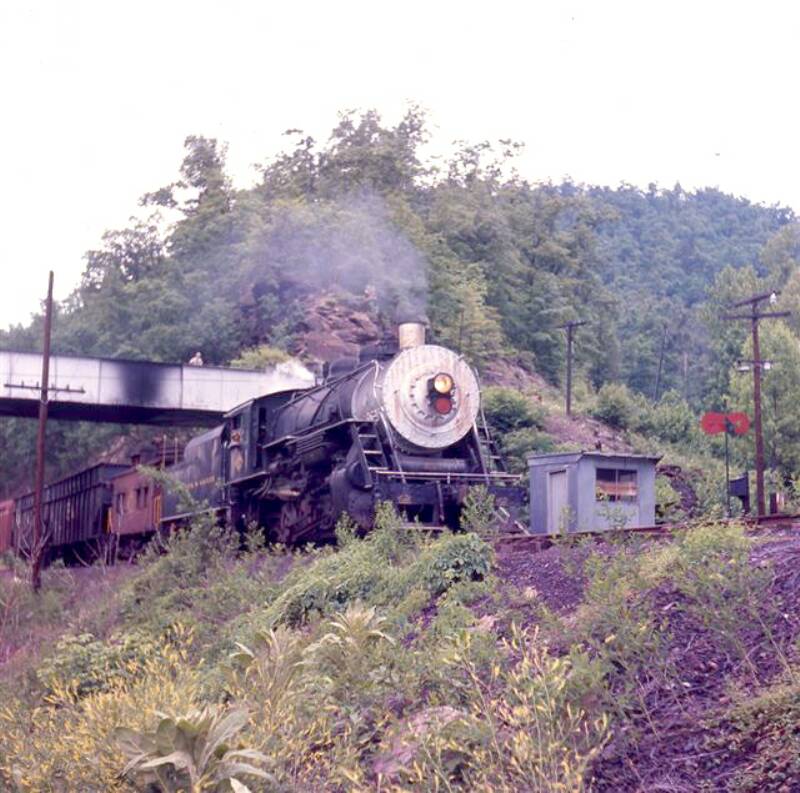
"Mystery Shack"
In the 1964 photo to the right there is a small gray shack that does not appear in any of the other photos that have surfaced. The photo is obviously taken near the site of the B&O station but the station is gone. The little shack does not appear in the 1961 Manning collection photo above unless it is just out of view to right.
Frank Criswell has offered a possible explanation: "Obviously the station is gone so this building probably contained the phone previously in the station for the crew to talk to the B&O dispatcher. This is a dark (unsignaled) territory, I believe, so the B&O crew would have to be able to communicate with the dispatcher when switching. The same holds true for the BC&G crew when interchanging cars on the B&O main. Previously this was taken care of by the B&O operator on duty in the station."
Larry Fellure - circa 1964
Phil Bonzon did this great drawing of the B&O station in preparation for building a model for his layout. It is just slightly compressed from the prototype. The model measures 16' X 36' but Phil believes the station was actually about 19' wide
NOTE: THIS DRAWING DOES NOT REFLECT THE VERTICAL PANELS BESIDE THE FRONT DOOR THAT ARE VISIBLE IN THE PHILLIPS PHOTO AT THE TOP OF THE PAGE. THAT PHOTO SURFACED AFTER PHIL DID HIS DRAWING.
Jeff Madden photo - date unknown
This photo by Jeff Madden appeared in William Warden's book WEST VIRGINIA LOGGING RAILROADS. It was taken from the same point on the road above the station, which is now gone as is the store. The pole from the order board is still standing although the arm is gone. The tell-tale is also still standing.
Notice the load of lumber on the flat car, presumably from the Swandale mill.
Of interest are the houses visible across the Buffalo Creek. Patsy and Herald Baughman remember as many as 10 house along that street, know to them as "red row".
Cody Burdett is of the opinion that the log loader is sitting at the B&O interchange in the photo above because in the last years of the logging operation the log train actually went up the B&O along the Elk River to work the so-called "Elk River Front". While not certain, Cody believes there may have been short branches leading off the B&O but that most of the loading was done right along the B&O main. By then B&O traffic had slowed and Cody doesn't think B&O trains ran every day. ERC&L Plymouth #20 was the engine in use during this time.
Dundon Station Drawings
This view of Motor "A" reveals some additonal partial glimpses of the sheds behind the B&O station. Herald Baughman provides the following insights:
" The building at the front of Motor A was a shop used by O. Byrne Hamrick, who was the car inspector for the BC&G. As such, he inspected incoming coal cars for any mechanical problems. The shop was a place where he spent idle time working on various projects, including outboard motors. I worked for him as a "helper" for an occasional 50 cents when I was about 12 years old. Byrne and I would take the boat motors out on the Elk River. I would run the motor and Byrne would stand in the front of the boat and guide us past the rocks in the shoals." Byrne lived across the footbridge in "Red Row".
"The little building on the left served as the office for the Bower Coal Sales. the door of that building was on the side facing the car road and was right in the curve of that road that went around the hill to the shop and office area of Dundon. The Bower's son, Gordon, used to be on duty in that building for coal shipments, weighing, selling, etc. The building next to this one was referred to as the "water treatment building'. I remember viewing pipes and valves when the door was open."
This excellent photo was taken 0n October 2, 1958 by John Phillips. It looks all the world like a photo of a model railroad! Beside showing several 3-bay hoppers on the spur behind the station, it shows how the railroad and the station were nestled between the hillside and the Elk River which is just out of sight at the bottom of the embankment in the foreground.
At least one detail is visible in this photo that does not appear in any of the others. There are two vertical panels with windows on either side of the pedestrian door on the right side of the station. It's a bit curious that there appears to be no loading dock in front of the freight door on the left side of the station.
Sheds
John Phillips photo 10-2-58
Frank Criswell had long wondered what the small white board protruding from the B&O station would have been (see three photos above). The photos to the right show a similar board on a former B&O station in Mitchell, IN. When in use one light would have had a yellow globe and the other a red globe. At night, the yellow light signaled a train order was waiting that would be hooped up to the train. If there was a form that had to be signed by the train crew the red light would be lit requiring the train to stop. During daytime hours, red and yellow placards would be placed on the board. Frank suggests that the Dundon board may have not had the two lights but appears to have had a spot light to illuminate the colored placards at night. Whether this system was used before, after or simultaneous with the signal tower is unknown.
Signal Board
Two photos Frank Criswell of B&O station at Mitchell, IN, 2009
